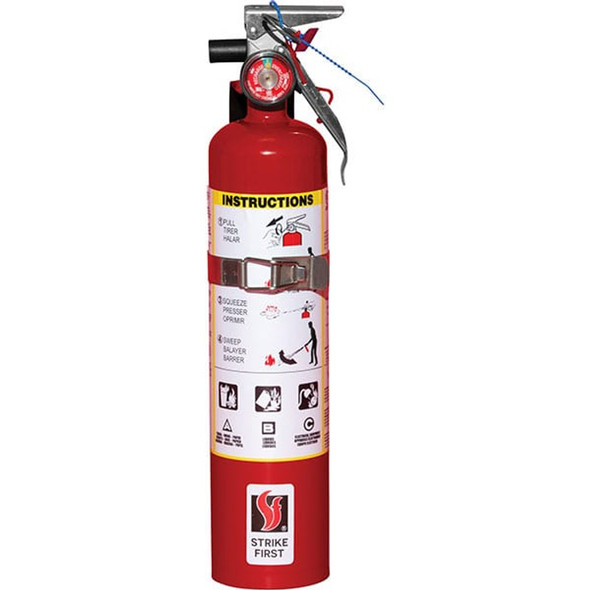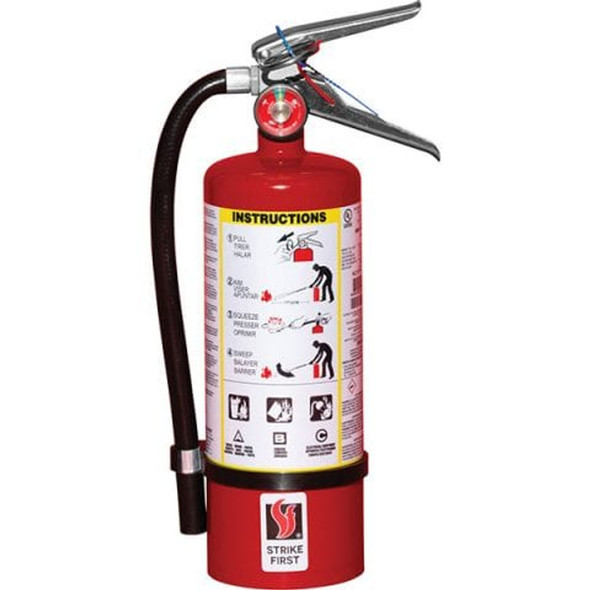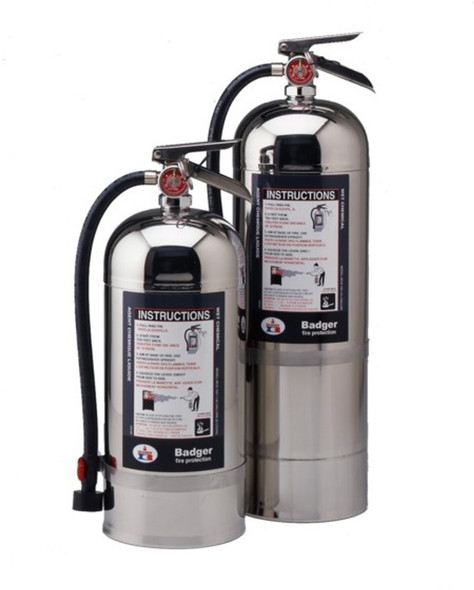
Fire Extinguishers
Fire Extinguisher Guide: Essential Safety Equipment for Emergency Protection
Fire extinguishers are portable firefighting devices that suppress small fires using pressurized extinguishing agents like dry chemicals, carbon dioxide, or foam. All Safety provides certified fire extinguishers designed for homes, businesses, and industrial facilities across Canada. These devices feature pressure gauges, safety pins, discharge nozzles, and classification ratings that indicate which fire types they combat effectively. Most fire extinguishers cost between $25-150 depending on size and type, with annual maintenance adding $15-30 per unit.
What Are Fire Extinguishers and How Do They Function?
Fire extinguishers work by removing one element from the fire triangle - heat, fuel, or oxygen. Class A units use water or monoammonium phosphate for ordinary combustibles like wood and paper. Class B extinguishers contain sodium bicarbonate or foam for flammable liquids such as gasoline and oil. Class C devices use non-conductive agents like carbon dioxide for electrical fires. Class D extinguishers employ specialized powders for combustible metals, while Class K units contain wet chemicals for cooking oil fires.
Key Benefits of Fire Extinguisher Systems
The primary benefits include immediate fire suppression capability, reducing property damage and potential injuries. Fire extinguishers provide 24/7 protection without requiring utilities or maintenance personnel. They enable quick response during the critical first minutes when fires remain manageable. All Safety extinguishers help businesses meet insurance requirements and building code compliance. These devices protect assets worth thousands of times their purchase cost when properly maintained and strategically placed.
Important Limitations and Safety Considerations
Fire extinguishers have significant limitations that users must understand. They work only on small fires - typically those covering less than 60 square feet. Most portable units provide only 8-25 seconds of discharge time, requiring quick and accurate application. Users need proper training to operate extinguishers safely and effectively. Class-specific limitations include water damage from Class A units, residue from dry chemical types, and oxygen displacement risks with carbon dioxide extinguishers. Never use water-based extinguishers on electrical or grease fires.
Who Should Use Fire Extinguishers and When
Property owners, facility managers, and designated safety personnel should use fire extinguishers when fires are small and contained. Use extinguishers only when you have a clear escape route and the fire department has been notified. Ideal scenarios include wastebasket fires, small cooking fires, or equipment malfunctions. However, evacuate immediately for large fires, unknown materials, or when smoke limits visibility. Training typically requires 2-4 hours and should be refreshed annually.
Fire Extinguisher Types and Costs
Residential units typically cost $25-75 for 2.5-5 pound ABC extinguishers. Commercial facilities need larger 10-20 pound units ranging from $75-150. Industrial applications may require wheeled units costing $300-800. Professional fire extinguisher maintenance services add $15-30 annually per unit. Total ownership costs over a 10-year lifespan typically range from $150-400 per extinguisher including purchase, inspection, and recharging.
Essential Selection Criteria for Different Applications
Choose extinguishers based on specific fire hazards in your environment. Homes benefit from multipurpose ABC extinguishers near kitchens, garages, and workshops. Offices need Class ABC units for general protection plus Class C for electrical equipment. Industrial facilities require specialized types - Class D for metal processing, Class K for commercial kitchens. All Safety recommends matching extinguisher size to room dimensions, with larger spaces requiring 10-20 pound units for adequate coverage.
Critical Installation and Placement Requirements
Mount fire extinguishers between 4-5 feet from floor level for easy access. Place units within 75 feet travel distance in most applications, closer for high-hazard areas. Ensure clear visibility with proper signage and lighting. Avoid locations near heat sources, potential impact areas, or where access might be blocked. All Safety installation services ensure code compliance and optimal placement for maximum effectiveness.
Maintenance Schedule and Professional Services
Monthly visual inspections check for damage, proper pressure, and clear access. Annual professional inspections verify internal components and certification compliance. Hydrostatic testing every 5-12 years depending on type ensures structural integrity. Recharge immediately after any use, even partial discharge. Replace units showing corrosion, damage, or when they exceed manufacturer recommendations typically ranging from 10-15 years for most types.
Common Problems and Troubleshooting Solutions
Low pressure readings indicate potential leakage requiring professional attention. Clogged nozzles need cleaning or replacement to ensure proper discharge. Corroded mounting brackets compromise safety and need immediate replacement. Missing safety pins create accidental discharge risks. Faded labels make proper identification difficult during emergencies. Regular inspection identifies these issues before they compromise fire protection capability.
Training Requirements and Safety Protocols
The PASS technique (Pull, Aim, Squeeze, Sweep) provides the basic operation method. Pull the safety pin, aim at the fire base, squeeze the handle, and sweep side to side. Maintain 6-8 feet distance from small fires for safety. Always keep your back to an exit route during operation. Training programs typically cost $50-150 per person and should include hands-on practice with different extinguisher types.
Building Code Compliance and Standards
NFPA 10 standards govern fire extinguisher selection, installation, and maintenance. Local fire codes may require specific types and quantities based on occupancy classification. UL listing ensures testing certification and performance standards. Regular inspection documentation proves compliance during fire department reviews. Professional fire panel inspection services help maintain comprehensive fire protection systems.
Key Takeaways for Fire Extinguisher Selection and Use
- Fire extinguishers provide immediate fire suppression for small fires but require proper training and quick response
- Different fire classes need specific extinguisher types - using wrong types can worsen fires or create hazards
- Regular maintenance including monthly checks and annual professional inspections ensures reliable operation during emergencies
- Proper placement within 75 feet travel distance and 4-5 feet mounting height enables quick access
- Total ownership costs including purchase, maintenance, and training typically range from $150-400 over 10 years
- Building codes and insurance requirements often mandate specific types and quantities for different occupancies
- Training in PASS technique and fire classification helps users respond effectively while maintaining safety
Quick Selection Checklist for Fire Extinguishers
- Identify specific fire hazards in your environment to determine required classifications
- Calculate coverage area and travel distances to determine size and quantity needed
- Verify UL listing and local code compliance for your application
- Consider total ownership costs including maintenance and inspection over 10-year lifespan
- Ensure mounting locations provide clear access and visibility with proper signage
- Plan for annual professional inspection and immediate recharging after any use
- Arrange proper training for all potential users in your facility
- Document maintenance records for compliance and insurance requirements
- Product
- Qty in Cart
- Quantity
- Price
- Subtotal
-

Steel Dry Chemical ABC Fire Extinguisher | 2.5 lb | StrikeFirst
Strike First
$57.49Steel cylinder Durable polyester powder paint finish Fully rechargeable Waterproof stainless steel gauge Bar coded label Metal valve & handles Complete with wall hook$57.49 -

Steel Dry Chemical ABC Fire Extinguisher | 5 lb | StrikeFirst
Strike First
$73.79Steel cylinder Durable polyester powder paint finish Fully rechargeable Waterproof stainless steel gauge Bar coded label Metal valve & handles$73.79 -

Steel Dry Chemical ABC Fire Extinguisher | 10 lb | StrikeFirst
Strike First
$109.99Steel cylinder Durable polyester powder paint finish Fully rechargeable Waterproof stainless steel gauge Bar coded label Metal valve & handles Complete with wall hook *Optional vehicle / marine bracket$109.99 -

Steel Dry Chemical ABC Fire Extinguisher | 20 lb | StrikeFirst
Strike First
$169.99Steel cylinder Durable polyester powder paint finish Fully rechargeable Waterproof stainless steel gauge Bar coded label Metal valve & handles Complete with wall hook *Optional vehicle / marine bracket$169.99 -

CO2 5lb FIRE EXTINGUISHER
$271.57* WELL SUITED FOR CORROSIVE ENVIRONMENTS* INDUSTRIAL STRENGTH ALUMINUM CYLINDER IS UP TO 30% LIGHTER THAN STEEL* STAINLESS STEEL HOSE BAND* STRONG IMPACT RESISTANT HORN* BAR CODED LABEL* EASY TO SERVICE MANUFACTURED AND TESTED TO THEFOLLOWING...$271.57 -

6L Wet Chemical Fire Extinguisher WC-100 | Class K - Kitchen | Badger
$363.386L Wet Chemical Fire Extinguisher | Class K - Kitchen | Badger WC-100 Made to stand up to Class K combustible kitchen fires, Badger Wet Chemical Extinguishers are easy to use and very effective in handling the difficult types of cooking media fire...$363.38 -

CO2 10lb FIRE EXTINGUISHER
$411.91* WELL SUITED FOR CORROSIVE ENVIRONMENTS* INDUSTRIAL STRENGTH ALUMINUM CYLINDER IS UP TO 30% LIGHTER THAN STEEL* STAINLESS STEEL HOSE BAND* STRONG IMPACT RESISTANT HORN* BAR CODED LABEL* EASY TO SERVICE MANUFACTURED AND TESTED TO THEFOLLOWING...$411.91 -

CO2 15lb FIRE EXTINGUISHER
$476.87* WELL SUITED FOR CORROSIVE ENVIRONMENTS* INDUSTRIAL STRENGTH ALUMINUM CYLINDER IS UP TO 30% LIGHTER THAN STEEL* STAINLESS STEEL HOSE BAND* STRONG IMPACT RESISTANT HORN* BAR CODED LABEL* EASY TO SERVICE MANUFACTURED AND TESTED TO THEFOLLOWING...$476.87 -

CO2 20lb FIRE EXTINGUISHER
$552.13* WELL SUITED FOR CORROSIVE ENVIRONMENTS* INDUSTRIAL STRENGTH ALUMINUM CYLINDER IS UP TO 30% LIGHTER THAN STEEL* STAINLESS STEEL HOSE BAND* STRONG IMPACT RESISTANT HORN* BAR CODED LABEL* EASY TO SERVICE MANUFACTURED AND TESTED TO THEFOLLOWING...$552.13
